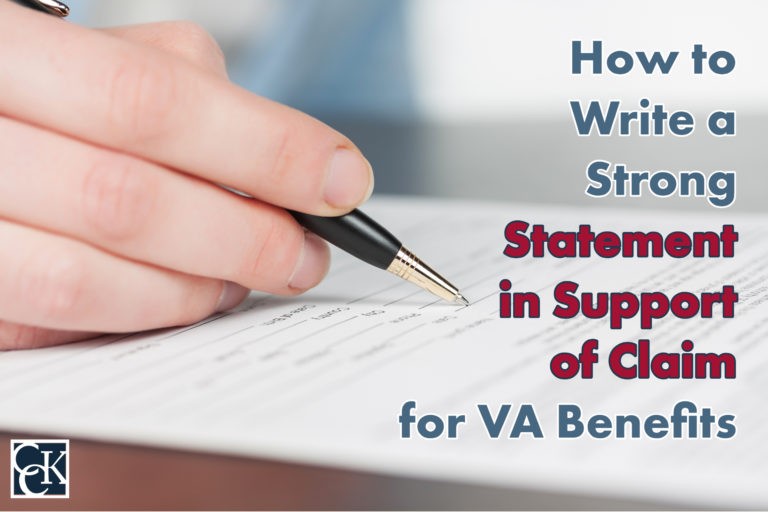How to Write a Strong Statement in Support of Claim for VA Benefits

CCK Law: Our Vital Role in Veterans Law
What is a Statement in Support of Claim?
A Statement in Support of Claim, also known as a Lay Evidence or a Witness Statement, is a VA form that veterans, their families, friends, former service members, etc. can use to provide information to substantiate a claim for VA benefits. The Statement in Support of Claim form, also known as a “buddy statement” when completed by other service-members, is officially called VA Form 21-10210.
Who Can Write a Statement?
Generally, there are three categories of people who can write a lay statement, or a Statement in Support of Claim:
- The Veteran—Veterans can write a Statement in Support of Claim to tell their own story. Statements provide a space for veterans to describe how their disability impacts their ability to work, perform the functions of daily living, or interact socially with family and friends. Here, veterans may also provide a first-hand account of the incident in-service that caused their disabling condition.
- Family, Friends, or Other Acquaintances—Friends, family members, coworkers, or anyone who witnesses the physical or social limitations a veteran’s disability presents can write a Statement in Support of Claim. However, it is important that the person writing the statement only speaks to what they know.
- Fellow Servicemembers—When a fellow servicemember writes a Statement in Support of Claim, it is often referred to as a “buddy letter.” This form of lay statement can be particularly useful because a fellow servicemember may be able to corroborate a veteran’s in-service stressor. For example, if a veteran’s disability came from a fall, a fellow veteran who was present can describe the incident.
What Can a Statement in Support of Claim Be Used For?
A Statement in Support of a Claim can be submitted to support many types of claims, such as claims for service connection, increased ratings, Individual Unemployability, and more.
For example, a veteran submitting a Statement in Support of Claim for service connection for Post-Traumatic Stress Disorder (PTSD) can write about their stressor, meaning the event that caused the veteran to develop PTSD, as well as the limitations their PTSD presents in daily life, such as an inability to go to the grocery store during the daytime due to large crowds. This form can help a veteran’s claim substantially, especially if the incident in service was not officially documented in military records. In this instance, a buddy statement, filled out on a separate VA Form 21-4138 by a fellow service member who witnessed the stressor, can also be quite beneficial to the veteran’s claim.
Another example would be if a veteran were seeking an increased rating for diabetes caused by exposure to Agent Orange, they could elaborate in a Statement in Support of a Claim that they now require three more insulin shots daily than when they were initially rated, which poses an additional burden on the veteran’s eating habits and daily life.
How to Complete a Statement in Support of Claim
At the top of this form, you will be asked to fill in basic identification information such as your name, social security number, date of birth, and so on. Be sure any information you provide is up-to-date and VA is aware of any changes to your address. You may hand write or type the information you provide on this form.
If the claimant is not the veteran, Section II is where they can provide their basic identification information. An example of this would be if the claimant is the veteran’s surviving spouse. Be sure to include identifying details for both the veteran and the person filling out the form.
In the next section entitled “Section III: Statement,” provide a well thought out statement that supports the claim for VA benefits. Be as detailed as possible in your explanation, and do not exaggerate or downplay the symptoms or limitations when completing the form. It is important to be honest about how your disability impacts your life.
Those filling out buddy statements on behalf of a veteran should also apply the same principles to writing their statements, such as listing specific instances when they witnessed the negative impacts of the veteran’s condition.
Supporting documents may be attached to the Lay/Witness Statement. If attaching additional papers to the form, the veteran will want to make sure that the statement section of the form acknowledges that there is an addendum attached. Finally, certify the document by signing and dating the form.

What Makes a Strong Statement?
Competence and Credibility
For VA to consider lay evidence, it must be deemed competent and credible. Competency refers to the knowledge of the individual completing the statement. Anyone who prepares a lay statement for a veteran must have personal knowledge of what is being discussed. Credibility speaks to the reliability of what is being said in the statement.
If VA determines that a lay statement is not credible, the veteran can respond with another lay statement to clarify what was written or submit a statement from another person.
For example, if VA noticed inconsistent dates mentioned across lay statements, the veteran can respond by explaining that they do not remember the exact dates and perhaps provide some context, such as the season during which an event occurred.
Honesty
Another key component of a strong lay statement is honesty. Exaggerating symptoms can often do more harm than good and bring into question the writer’s credibility. Speaking to any event that a person does not have knowledge of is also problematic and can negatively impact a veteran’s claim. For example, if a veteran has a buddy letter where a fellow servicemember describes an event they were not present for or did not witness, this could discredit the veteran’s case.
Contrarily, it is important not to downplay symptoms either. If a veteran is writing a lay statement, they could downplay their symptoms, which could cause VA not to issue an accurate rating or even deny service connection entirely. While it can be hard to be honest about symptoms out of embarrassment or fear of stigma, being honest gives veteran’s the best chance of receiving the disability rating they deserve.
Detail-Oriented
Any Statement in Support of Claim, whether it is written by the veteran themselves, their family member, or a fellow servicemember, should be extremely detailed because details can give VA the information it may need to grant a specific rating. For example, if a spouse is writing a lay statement about the veteran’s symptoms, they should be sure to include specific examples of the symptoms the veteran experiences and how they affect their day-to-day life. If a veteran is writing about their in-service event or stressor, they should be sure to include details about the time, place, who else might have been there, and what happened.
How to Submit a Lay Statement VA Form
As of January 17, 2021, the U.S. Department of Veterans Affairs (VA) requires that lay evidence be submitted using VA Form 21-10210. This form contains the following sections:
- Identifying the veteran
- Claimant information (if the claimant is not the veteran)
- The written statement
- The layperson’s contact information (e.g., phone number, email address, mailing address)
- A section to certify and sign the statement
If you run out of space for your statement in Section III, you can attach an addendum, or additional papers, to continue your statement. Veterans should be sure to note on the form that an addendum is attached if they are submitting any additional pages.
If more than one person is submitting lay evidence on your behalf, each person will have to fill out a separate VA Form 21-10210.
VA Personal Statement Examples
For your reference, find examples of Statement in Support of Claim below:
Please note that these are merely examples and should not be submitted in support of any claim for VA disability benefits. This information is not legal advice and has been made available for educational purposes to provide veterans, their families, and friends a general understanding of how these statements should be drafted.
About the Author
Share this Post
